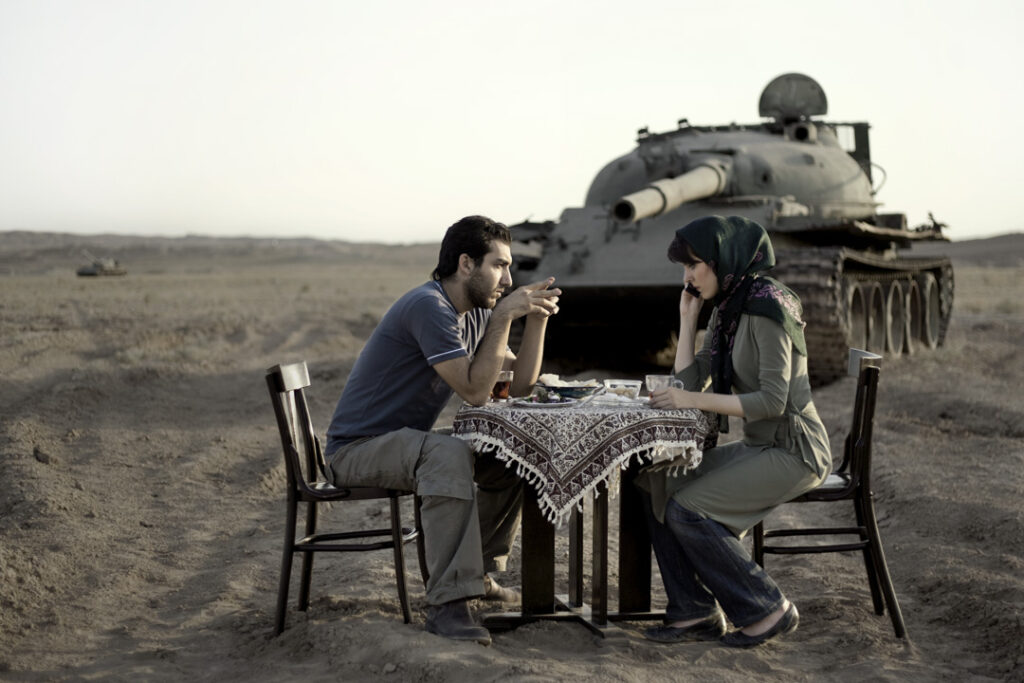
In her most recent works, Dashti has explored, through her highly stylised, densely poetic observations of human and plant-life, the innate kinship between the natural world and human migrations. Fascinated with human-geographical narratives and their interconnection to her own personal experiences, Gohar Dashti believes that nature is what connects her to the multiple meanings of ‘home’ and ‘displacement’, both as conceptual abstractions, and as concrete realities that delineate and contour our existence. The result is a series of quirky landscapes and portraits, as lush as they are arch, inciting questions about the immense, variegated, border-eschewing reach of nature – immune to cultural and political divisions – and the ways in which immigrants inevitably search out and reconstruct familiar topographies in a new, ostensibly foreign land.
Today’s Life and War | 2008
The series “Today’s Life and War” emerged from Gohar’s experiences during the eight-year Iran-Iraq War. This conflict has had a strong symbolic influence on the emotional life of her generation. Although they may be safe within the walls of their homes, the war continues to reach them through newspapers, television and the Internet. This body of work represents war and its legacy, the ways in which it permeates all aspects of contemporary society. She captures moments that reference the ongoing duality of life and war without precluding hope. In a fictionalised battlefield, Gohar shows a couple in a series of everyday activities: eating breakfast, watching television, and celebrating their wedding. Though they do not visibly express emotion, the man and woman embody the power of perseverance, determination, and survival.
- This body of work represents war and its legacy, the ways in which it permeates all aspects of contemporary society.
Iran Untitled | 2013
In Iran, Untitled, Gohar Dashti presents a haunting counter-narrative of her homeland, stepping away from traditional storytelling to evoke a sense of suspended reality. Set in a vast, empty desert – more of a non-place than a defined location – the series portrays scenes of human interaction that are as silent as they are evocative. Without spoken words, the relationships are communicated through the bodies of the figures: a group raises their hands in protest, a wedding takes place on a carpet in the middle of nowhere, women mourn in silence, and soldiers engage in a war game without borders.
Gohar’s desert is both expansive and confining, offering glimpses of life rather than a full story. Her images ask viewers to complete the narrative themselves, invoking a sense of ambiguity and introspection. With this work, she blurs the line between reality and imagination, creating a powerful visual meditation on place, identity, and the human experience.
Home | 2017
In Home, Gohar Dashti invites us into surreal, dreamlike settings where nature has completely overtaken abandoned homes. These images depict houses stripped of human presence, allowing nature to reclaim and dominate the space. The series reflects on the power of nature to consume what is left behind, raising deeper questions about displacement and the aftermath of war.
For Gohar, war is both a global reality and a personal memory from her childhood, often informing her work. Home explores the intersection of nature and human conflict, examining what happens to the environment when populations are displaced by war. While people are transient, nature remains a constant force, a silent witness to the destruction – and eventual reclamation – of human spaces. Through these lush, evocative scenes, Gohar offers a poignant reflection on the enduring relationship between nature and human displacement.
Land/s | 2019
In Land/s, Gohar Dashti delves into the complexities of migration, displacement, and the connection between humans and landscapes. Inspired by stories of immigrants longing for home, the series captures the profound bond between nature and identity. Gohar explores how natural environments transcend borders, providing a sense of familiarity even in foreign lands. Yet, as she reflects on her own experiences, there’s a paradox – while a tree may resemble one from her childhood in Iran, its roots, fragrance, and sounds are shaped by a different soil, offering a new, layered connection.
In Land/s, Gohar creates intricate staged interventions, blending disparate environments from two continents to challenge our perceptions of place and belonging. These landscapes aren’t mere montages; they are the result of her journeys across seas, mountains, and forests, constructing images that evoke both uncertainty and recognition. Through this series, she invites us to consider how the intimate relationship between humans and nature can foster new narratives, questioning the meaning of home in a world shaped by migration.
Gohar Dashti is an Iranian artist known for her series of staged photographs that explore themes of history, memory, and social commentary.
gohardashti.com | www.instagram.com/dashtigohar














